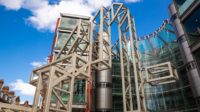London's high-rise architecture has a culinary bent of late. First there was the “Gherkin” by architect Norman Foster; now there is the “Cheese Grater” by Rogers Stirk Harbour and Partners, London. The city's next major high-rise, mothballed for three years during the foundation stage but about to spring to life, got its nickname thanks to its silvery leaning south facade. Passersby likely will find the profile of 122 Leadenhall Street to be the building's most striking feature. But project engineers are more intrigued by the node connections within the structure's expressed structural-steel megaframe.

The 224-m-tall building, nicknamed Cheese Grater because of its one sloping facade and expressed structure, was mothballed three years ago.
Photo courtesy of British Land
Prefabricated nodes to ease construction and provide joints at Richard Rogers' 225 m tall "Cheesegrater" tower.
“The most interesting part of what we have been doing over the past several months has been the analysis and detail design of these nodes,” says Damian Eley, associate director with the project's structural designer, Arup Group, London. “It's visual engineering,” he adds.
Three competitors—London-based Skanska Construction U.K. Ltd.; Mace Ltd., along with Laing O'Rourke Construction Ltd., Dartford; and Sir Robert McAlpine Ltd., Hemel Hempstead—are due to bid on the construction contract soon. Co-developer British Land Co. PLC., London, with Oxford Properties Group, Toronto, hopes to get a contract signed this summer, aiming for shell-and-core completion around mid-2014, says Matthew White, construction executive with British Land. With contractors hungry for work, “it's the best time to secure a lump-sum, fixed-price contract,” he says.
Designed by Rogers Stirk Harbour, the 224-meter-tall, 56,700-sq-m building will rise from a roughly 60 x 50-m footprint. Rectangular floor plates will reduce in area from 1,950 sq m at the lowest level to around 560 sq m at the highest. The structural-steel core will be anchored to the main frame's vertical north side.
The design for a sloping south side was driven by the need to avoid blocking views of St. Paul's Cathedral, just over one kilometer to the west, says White. Unobstructed sightlines to the 17th-Century cathedral are an important zoning criterion in central London, he explains.
Having no central core, the building will be stabilized by external megaframes of inclined steel columns with H-sections up to 80 centimeters sq. The building's composite floors will incorporate 70-cm-deep steel beams spanning between vertical steel columns. The megaframe columns will intersect with the floor beams at nodes every seven levels.
“There has been a huge effort to develop [node] details,” says Eley. Using Tekla Structures software, the designers worked with steel subcontractor William Hare Structural Engineers Ltd., Bury, to develop buildable nodes. Shop fabrication will allow the nodes to be welded, rather than bolted, for increased strength, says Eley. “We took the bolted connections away from the joints,” he says.
Weighing a maximum of 30 tonnes each, the nodes will be up to 6 m tall and 3 m wide. Large threaded bolts, up to 7.6 cm in diameter, will connect ends of the nodes' arms to the rest of the building frame. To transfer the large bolt forces, box sections will be welded into the ends of the abutting I-section steelwork. These internally stiffened bolt boxes will be about 50 cm long.
British Land started foundation work on the Leadenhall Street building in 2007, with Bovis Lend Lease Ltd., London, as its construction manager. To accelerate construction, the previous medium-rise building was demolished concurrently on-site, with a large crash deck protecting construction workers below.
“We were getting on with procurement of the project as a whole when the credit crunch came along,” says White.
With about half the piling done and the basement box built, British Land terminated contracts and mothballed the site in spring 2008. Early last year, the developer negotiated a joint-venture agreement to share continuing development of the project with Oxford. It also re-engaged the original design team but not Bovis. British Land had developed the project sufficiently to secure robust construction bids and no longer felt the need for a construction manager, says White.




Post a comment to this article
Report Abusive Comment